Plunge into the enigmatic realm of biblical titans, where divine lineage and human tales converge, beckoning a deeper dive into ancient mysteries.
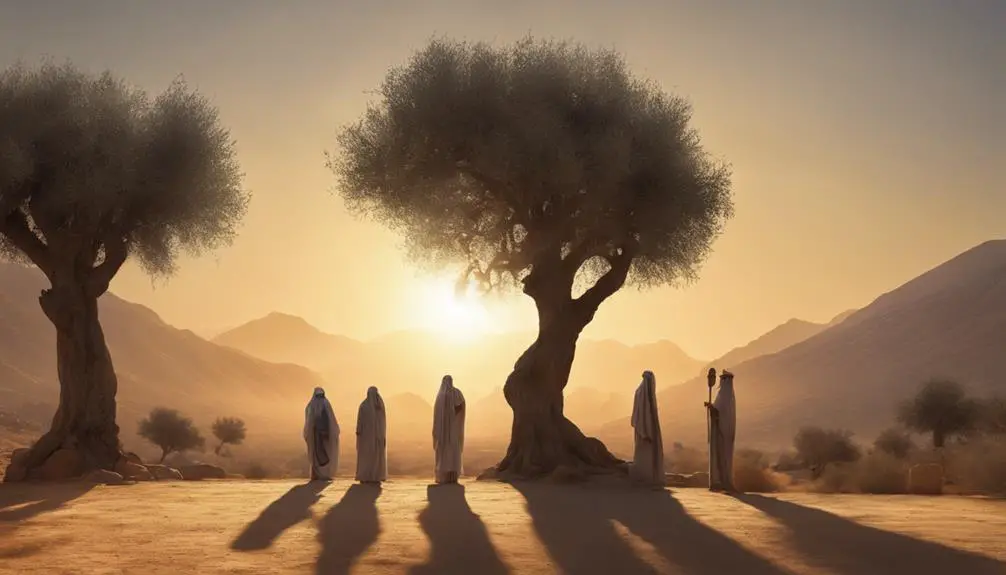
Titans in the Bible
Navigating the biblical landscape, you might stumble upon giants, casting long shadows over ancient texts. The Nephilim, for example, are shrouded in mystery, towering at the crossroads of divine and human narratives.
You've likely heard of Samson, a titan among mere mortals, whose strength defied explanation. But have you pondered the origins and legacies of these formidable beings? Their stories, woven through scripture, hint at a world where the lines between gods and men blur.
As you explore further, consider what these tales reveal about the nature of power, faith, and the human spirit, inviting a deeper understanding of the biblical world.
Key Takeaways
- Biblical titans, like the Nephilim and Samson, blend myth and history to explore divine-human interactions.
- Giants in biblical narratives serve as symbols of the challenges and adversities faced by the Israelites.
- The story of Samson illustrates the complexity of power, faith, and the human condition.
- Delilah's betrayal of Samson highlights themes of treachery and redemption within the broader narrative of divine favor and human frailty.
The Nephilim: An Overview

Delving into the ancient texts, one finds that the Nephilim, often shrouded in mystery, are described as the mighty offspring of 'the sons of God' and 'the daughters of men' before the Flood. The ambiguity surrounding their true nature and existence has led to a variety of origin theories. Scholars have speculated that these beings could represent a diluted divine lineage or perhaps allegories for the moral degradation of humanity at the time. You'll find that interpretations vary widely, ranging from literal giants walking the earth to symbolic representations of fallen morality or great men of renown.
The cultural impact of the Nephilim narratives is significant and far-reaching. These stories have permeated various aspects of literature, art, and theology, influencing how societies conceptualize the intersection of the divine and the mortal. This cross-cultural fascination underscores the universal appeal of exploring the boundaries of human existence and divine influence. The Nephilim, by straddling these realms, serve as a compelling focal point for discussions about power, morality, and the consequences of divine-human interactions.
In your exploration, you'll discover that the Nephilim aren't merely historical or mythological curiosities but are embedded within the cultural and theological fabric of numerous societies. They represent a complex blend of fear, reverence, and curiosity that challenges one's understanding of the natural and supernatural world. The ongoing scholarly debate and popular interest in these figures highlight the enduring allure of the unknown and the power of myth to shape human understanding across ages.
Sons of God and Daughters of Men
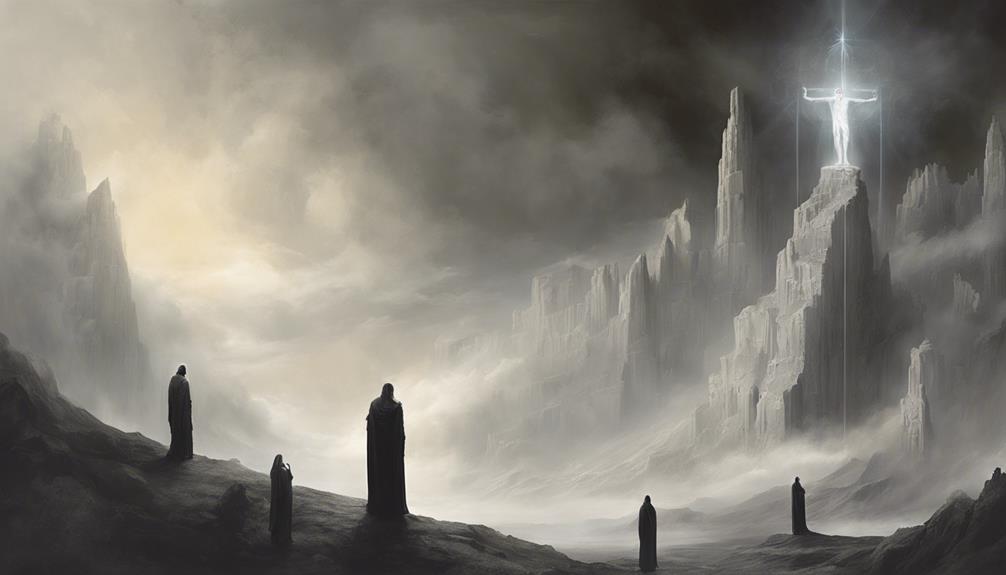
The term 'Sons of God and Daughters of Men' refers to a biblical narrative that has sparked considerable scholarly debate regarding its interpretation and implications for understanding ancient beliefs about divine-human interactions. This story, found in the early chapters of Genesis, describes how the 'sons of God' saw that the 'daughters of men' were beautiful and took them as wives, a situation that precedes the Great Flood. This narrative has been interpreted through various lenses, from literal historical accounts to symbolic mythology.
The concept of divine interbreeding suggested in this narrative isn't unique to the Hebrew Bible but finds echoes in mythological parallels across numerous cultures. These parallels often depict gods or celestial beings mingling with humans, giving rise to heroes or demigods with extraordinary abilities.
- The notion of divine beings engaging with humans evokes a sense of wonder and curiosity about the possibilities of existence beyond our understanding.
- It challenges our perceptions of divinity and humanity, blurring the lines between the celestial and the terrestrial.
- The narrative invites contemplation on the ethics of power dynamics between the divine and the mortal.
- It stimulates the imagination, conjuring images of a world where the divine directly influences human affairs.
- This story resonates emotionally, tapping into universal themes of love, desire, and the consequences of forbidden relationships.
In scholarly discourse, these themes are explored not only to understand the text itself but also to gain insights into the worldview and cultural context of the ancient societies that produced these narratives.
Giants in the Promised Land
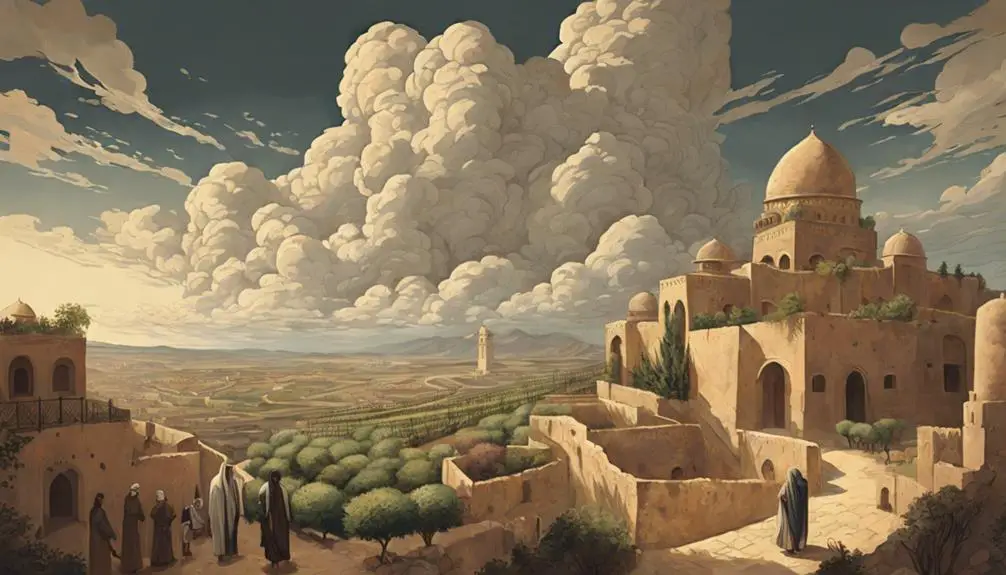
Building on the theme of divine-human interactions, the biblical narrative further unfolds with the mention of giants in the Promised Land, a development that adds another layer to our understanding of ancient texts and their portrayal of extraordinary beings. This account, deeply embedded within the conquest narratives, intertwines with Canaanite myths, suggesting a cultural cross-pollination that enriches the tapestry of ancient Near Eastern traditions. The giants, often perceived as formidable adversaries, symbolize the challenges the Israelites face, embodying the land's divine protection and the supernatural hurdles to be surmounted.
Archaeological findings, while not providing direct evidence of giants, offer insights into the mythological and cultural contexts from which these stories emerge. Excavations in regions associated with ancient Canaan have unearthed artifacts and structures that reflect a society rich in myth and legend, highlighting the interplay between historical realities and mythological narratives.
The mention of giants serves not only as a narrative device to heighten the drama of conquest but also as a reflection of the Israelites' perception of the land and its inhabitants. This framing underscores the perceived otherness and hostility of the land's occupants, casting the Israelites' struggles in a cosmic light and aligning their endeavors with divine will.
Analyzing these narratives through the lens of Canaanite myths and archaeological findings provides a broader understanding of how ancient societies conceptualized the divine, the supernatural, and the heroic. It reveals the complexity of ancient texts and their capacity to convey profound truths about human experience, divine interaction, and the eternal quest for belonging and identity.
The Legacy of the Rephaim
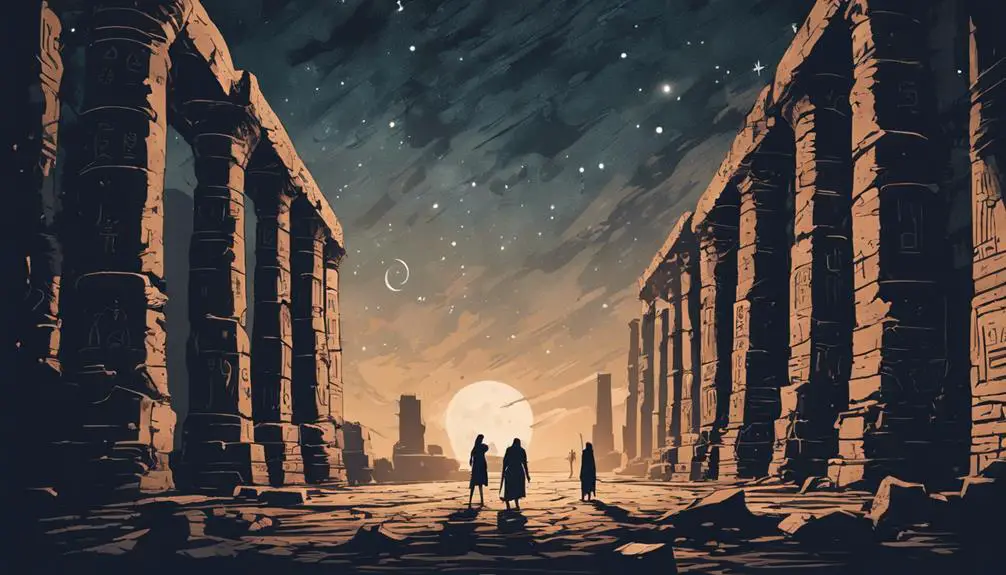
The Rephaim, mentioned in various biblical texts, hold a significant place in the ancient narratives, reflecting both historical and mythological dimensions of their legacy. Their story intertwines with ancient myths and cultural interpretations, painting a complex picture of their existence and impact on early civilizations. Analyzing their legacy offers a window into how ancient societies understood the world around them and how they integrated these colossal figures into their spiritual and cultural frameworks.
The enduring mystery of the Rephaim captivates scholars and enthusiasts alike, sparking debates and research into their true nature and origins.
Their depiction in biblical texts as formidable warriors and giants evokes a sense of awe and fear, highlighting the ancient people's fascination with the extraordinary.
The cultural interpretations of the Rephaim vary widely, reflecting the diverse ways in which societies have made sense of these enigmatic figures throughout history.
Ancient myths surrounding the Rephaim contribute to our understanding of early religious beliefs and the role of myth-making in shaping cultural identities.
The legacy of the Rephaim serves as a testament to the power of storytelling in preserving history, with their tales echoing through generations and continuing to influence modern interpretations of the past.
Samson: A Titan Among Men
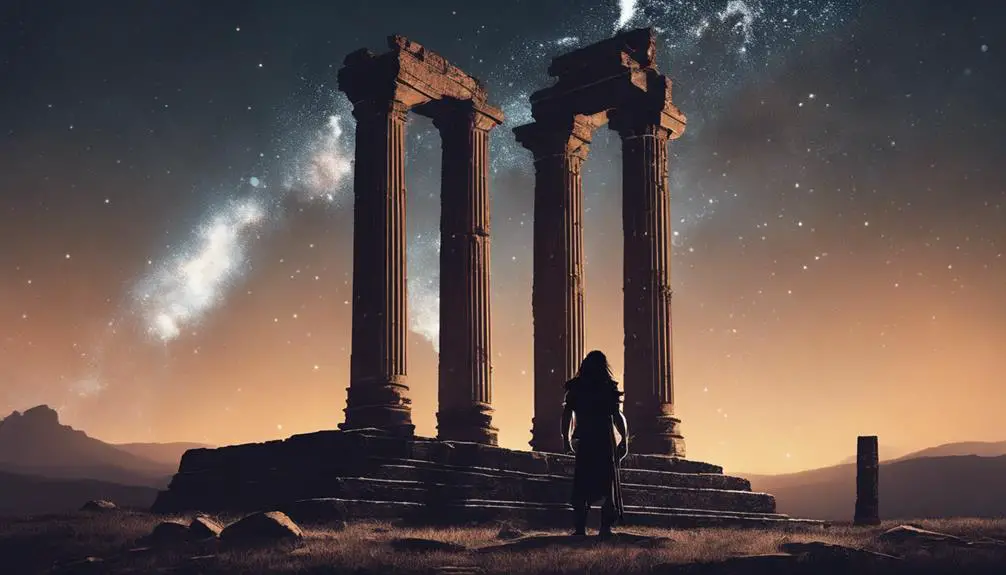
Reflecting on the legacy of the Rephaim illuminates the role of extraordinary figures in ancient narratives, a theme that continues with the story of Samson, who stands as a titan among men in biblical lore. Samson's narrative, deeply embedded within the Book of Judges, showcases a unique blend of divine favor and human frailty. His extraordinary strength, bestowed upon him as a Nazirite dedicated to God, sets him apart as a singular force against the Philistines, the oppressors of the Israelites.
Yet, it's crucial to note that Samson's strength isn't merely a tale of physical prowess; it serves as a metaphor for the struggle between divine destiny and human weakness. This duality reaches its zenith with Delilah's betrayal, a pivotal moment that encapsulates the tragic fall of a hero. Delilah, whose name has become synonymous with treachery, plays a central role in unraveling the secret of Samson's strength, leading to his capture and ultimate downfall.
This episode raises questions about the nature of strength and the vulnerabilities inherent in human nature. Samson's eventual capture and his final act of bringing down the Philistine temple, thereby fulfilling his destiny, underscore the complexity of his character. He embodies both the zenith of divine empowerment and the nadir of human susceptibility.
In analyzing Samson's story, one observes a timeless narrative of fallibility, redemption, and the enduring human quest for strength in the face of adversity. Samson's legacy, marked by both his unparalleled strength and Delilah's betrayal, serves as a poignant reminder of the multifaceted nature of biblical titans.
Frequently Asked Questions
How Do the Descriptions of "Titans" in the Bible Compare to Those in Greek Mythology?
You won't find 'titans' in the Bible as you do in Greek mythology. The Greek pantheon includes titans as precursors to gods, embodying natural forces and moral concepts.
When you explore mythological parallels, it's clear the biblical narratives focus more on moral and spiritual lessons, rather than embodying elements of nature or human traits in divine forms.
Thus, comparing them directly might lead to misconceptions about their respective roles and significance.
Are There Any Explicit References to "Titans" in the Biblical Text, or Is This a Modern Interpretation?
You'll find that explicit references to 'titans' aren't present in the biblical text. This concept is more of a modern interpretation, shaped by translation challenges and cultural symbolism.
Scholars argue that interpretations often reflect contemporary perspectives, making it crucial to understand the historical context of biblical translations. Therefore, what you might associate with 'titans' stems from later interpretations, not direct mentions or descriptions in the original scriptures.
How Have Different Cultures and Religions Outside of Judaism and Christianity Interpreted the Biblical Giants?
You'll find that cultures and religions beyond Judaism and Christianity, like Islamic perspectives and Hindu interpretations, have their own views on biblical giants. Islamic texts sometimes parallel these stories, focusing on beings with immense stature and power, though they're not always directly equated to giants.
Similarly, Hindu scriptures mention beings of great size and strength, but these narratives are embedded in a broader cosmological and spiritual framework, distinct yet occasionally overlapping with biblical tales.
What Role Do the So-Called Titans Play in Apocalyptic Literature and Eschatological Beliefs Within the Bible?
You might think giant symbolism doesn't fit in scholarly analysis, but it's crucial for understanding apocalyptic visions.
These giants aren't just mythical creatures; they symbolize overwhelming chaos and moral decay, challenging humanity before the end times.
In apocalyptic literature, their presence underscores humanity's need for divine intervention, mirroring eschatological beliefs that predict a struggle between good and evil, leading to a renewed world.
Analyzing these symbols offers deep insights into biblical narratives and prophetic messages.
How Have Archaeological Discoveries Influenced Our Understanding of the Historical Basis for the Giants Mentioned in the Bible?
Archaeological discoveries haven't definitively proven the historical basis for giants mentioned in ancient texts. While you might've heard of giant skeletons fueling theories about the Nephilim origins, these finds often lack scientific verification or are misinterpreted. Scholars analyze these discoveries with a critical eye, aiming to separate myth from historical fact.
Your understanding of these beings is shaped by evidence that, so far, suggests a more symbolic than literal interpretation.
Conclusion
So, you've waded through the ancient tales of biblical titans, marvelling at the Nephilim, puzzling over the cosmic Tinder matches between the Sons of God and Daughters of Men, and tiptoeing through territories plagued with giants.
You've dissected the lore of the Rephaim and cheered for Samson, the original strongman. Congratulations! You're now versed in the celestial soap opera that's biblical mythology.
Remember, every giant story you've encountered is a step towards understanding humanity's colossal fascination with the divine and the monstrous.



Sign up